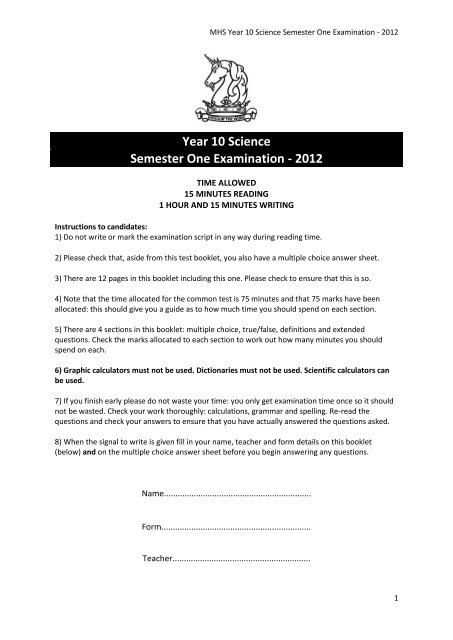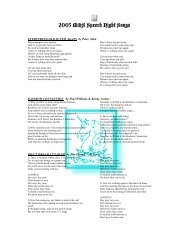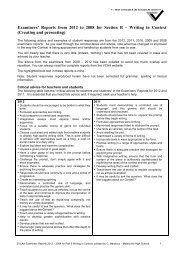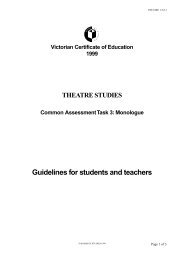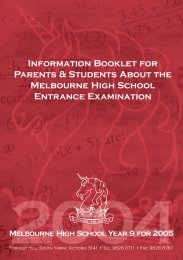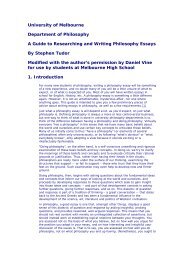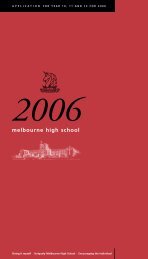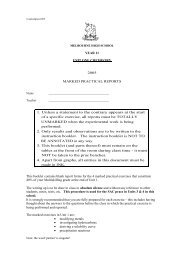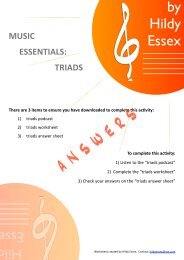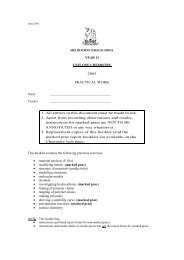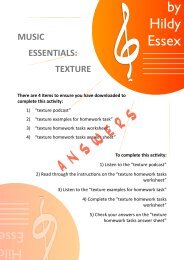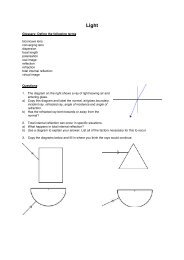2012 semester one year 10 exam
2012 semester one year 10 exam
2012 semester one year 10 exam
You also want an ePaper? Increase the reach of your titles
YUMPU automatically turns print PDFs into web optimized ePapers that Google loves.
MHS Year <strong>10</strong> Science Semester One Examination - <strong>2012</strong>Year <strong>10</strong> ScienceSemester One Examination - <strong>2012</strong>TIME ALLOWED15 MINUTES READING1 HOUR AND 15 MINUTES WRITINGInstructions to candidates:1) Do not write or mark the <strong>exam</strong>ination script in any way during reading time.2) Please check that, aside from this test booklet, you also have a multiple choice answer sheet.3) There are 12 pages in this booklet including this <strong>one</strong>. Please check to ensure that this is so.4) Note that the time allocated for the common test is 75 minutes and that 75 marks have beenallocated: this should give you a guide as to how much time you should spend on each section.5) There are 4 sections in this booklet: multiple choice, true/false, definitions and extendedquestions. Check the marks allocated to each section to work out how many minutes you shouldspend on each.6) Graphic calculators must not be used. Dictionaries must not be used. Scientific calculators canbe used.7) If you finish early please do not waste your time: you only get <strong>exam</strong>ination time once so it shouldnot be wasted. Check your work thoroughly: calculations, grammar and spelling. Re-read thequestions and check your answers to ensure that you have actually answered the questions asked.8) When the signal to write is given fill in your name, teacher and form details on this booklet(below) and on the multiple choice answer sheet before you begin answering any questions.Name................................................................Form.................................................................Teacher............................................................1
MHS Year <strong>10</strong> Science Semester One Examination - <strong>2012</strong>Section 1: Multiple ChoiceWrite your selections on the answer sheet supplied. Please place the answer sheet in thisbooklet when you hand in this <strong>exam</strong>. This section is worth 25 marks.1. Due to the introduction of the poisonous cane toad to Australia around 80 <strong>year</strong>s ago, thepredatory red-bellied black snakes have evolved to have smaller heads (so they can only eatthe smaller, less poisonous toads) and larger bodies (so they can more easily process thepoison). This change in snake body shape was NOT caused by:A. The snakes with larger heads and smaller bodies dying after eating cane toadsB. The snakes acquiring smaller heads and larger bodies to deal with eating cane toadsC. The toads being a new selective pressureD. Advantageous traits being inherited by offspring2. Krishna observed that a herbivore species had large legs and could run very fast. Hehypothesised that they evolved these adaptations after a fast running predator migratedinto the region, causing the ancestral herbivores to develop stronger leg muscles so theycould try and out-run the new predator. This adaptation was inherited by successivegenerations, who in turn developed stronger leg muscles so they could run even faster.Krishna’s hypothesis can best be explained as:A. Darwinian EvolutionB. Mendelian EvolutionC. Lamarckian EvolutionD. Neo-Darwinism (a combination of Darwinism and Mendelism)3. What is the correct order of events for speciation to occur?A. Variation in the population –> geographic isolation –> natural selection –> reproductiveisolation –> speciationB. Geographic isolation –> variation in the population –> natural selection –> reproductiveisolation –> speciationC. Variation in the population –> reproductive isolation –> natural selection –> geographicisolation –> speciationD. Variation in the population –> natural selection –> geographic isolation –> reproductiveisolation –> speciation4. Which of the following is the best <strong>exam</strong>ple of how fossils are used as evidence of evolution.A. Fossils are only used to demonstrate links between extinct species and those that areliving todayB. Fossils are only used to demonstrate links between different types of extinct speciesC. Fossils cannot be used to <strong>exam</strong>ine homologous structures between extinct species andthose that are living todayD. Fossils can be used to <strong>exam</strong>ine analogous structures between extinct species and thosethat are living today2
MHS Year <strong>10</strong> Science Semester One Examination - <strong>2012</strong>24. Which list below contains only ionic compounds?A. LiH, K 2 O, FeCl 3B. NaCl, P 2 O 5 , ZnBr 2C. SF 6 , BaO, Pb 3 N 2D. HNO 3 , Fe, CaS25. Which of the following is the correct order of decreasing reactivity?A. Iron, potassium, magnesium, gold, copperB. Magnesium, copper, iron, gold, potassiumC. Gold, potassium, iron, copper, magnesiumD. Potassium, magnesium, iron, copper, gold6
MHS Year <strong>10</strong> Science Semester One Examination - <strong>2012</strong>Section 2: True and FalseIndicate whether the following statements are true or false by placing 'T' for true or 'F' forfalse in the boxes following each statement. This section is worth 5 marks.Transitional organisms are only found in the fossil recordIf a homozygous recessive mother had two children with a heterozygousfather, <strong>one</strong> child would be heterozygous and the other homozygous recessiveIf a truck and a car have a head-on collision, they will both bounce off eachother to same extent due to the Third Law of MotionVelocity can be determined by the gradient of a distance vs time graphElectr<strong>one</strong>gativity increases from left to right across a Period(5 marks)Section 3: DefinitionsGive a term to fit each of the following definitions. This section is worth 5 marks.body structures that have reduced in size, due to generations of disusecellular structures that are comprised of long strands of DNA that aretightly coiled around themselvesthe maximum speed an object will reach during falling, can change dueto changes in shape affecting air resistancea contact force created when an object moves across a surfacean atom that has gained electrons and has become negatively charge(5 marks)7
MHS Year <strong>10</strong> Science Semester One Examination - <strong>2012</strong>Section 4: Extended QuestionsGive detailed answers to each question in the spaces provided. Answers that do not show allrequired mathematical working will not obtain full marks. This section is worth 50 marks.1. The genetic code in all organisms is determined by specific sequences of G, T, A and Cs.Mutations are changes in the genetic code, e.g. a G can be replaced with a T.Several factors can cause DNA to mutate.a. List two different factors that can cause DNA to mutate.(2 × 1 = 2 marks)b. i. Complete the equation:Evolution = Mutations + ________________________________(1 mark)ii. Explain your above answer.______________________________________________________________________________________________________________________________________________________________________________________________________________________________________________________________________________________________________________________________________________________________________________________________________________________________________________________________________________________________________________________________________________________________________________________________(2 marks)2. Anchondroplasia is a dominant genetic disorder that is a commoncause of dwarfism. The average height of male anchondroplasticdwarves is 131 cm, and 123 cm for females. Approximately 1 in25,000 people display this form of dwarfism.People with this disorder have <strong>one</strong> normal copy of the FGFR3 geneand <strong>one</strong> mutant copy. Two copies of the mutant gene results in thedeath of the foetus and miscarriage.8
MHS Year <strong>10</strong> Science Semester One Examination - <strong>2012</strong>a. Complete the following punnet square for a cross between two anchondroplastic dwarves(make sure to use appropriate allele symbols).b. What is the chance that a child of this cross would also be a dwarf?(2 marks)c. Can two non-dwarves have a dwarf child? Explain your answer.(1 mark)________________________________________________________________________________________________________________________________________________________________________________________________________________________________________________________________________________________________________________________________________(2 marks)3. An adaptation is any characteristic that helps an organism to survive. All living organismspossess three types of adaptations – physical (i.e. external, structural), physiological (i.e.internal, biochemical), and behavioural (i.e. how the organism acts).Venus fly-traps grow in nutrient-poor soils. In order to obtain important nutrients that areabsent in the soil (such as nitrogen), these plants catch insects using traps that have evolvedfrom normal leaves.a. Complete the following table regarding the adaptations that have evolved in these plants.Catching the insectsType of adaptation:Enzymes used to digest the caught insectsModified leaves used to catch the insectsPherom<strong>one</strong>s used to lure insects into thetrap(4 × 0.5 = 2 marks)9
MHS Year <strong>10</strong> Science Semester One Examination - <strong>2012</strong>Cacti, like Venus fly-traps, also have modified leaves. Cactus spines evolved from normalleaves and are used for protection against predators.b. Are cactus spines and Venus fly-trap traps an <strong>exam</strong>ple of homologous or analogousstructures? Explain your answer.________________________________________________________________________________________________________________________________________________________________________________________________________________________________________________________________________________________________________________________________________c. What type of evolution has occurred between these two species of plants?(2 marks)(1 mark)4. Examine the following graph showing how velocity varied with time for a runner travellingalong a straight stretch of road.a. Identify what is happening at the following time intervals:4 to <strong>10</strong> seconds18 to 24 seconds(2 × 0.5 = 1 mark)<strong>10</strong>
MHS Year <strong>10</strong> Science Semester One Examination - <strong>2012</strong>b. At what time interval was the runner’s acceleration the greatest? What was hisacceleration? Explain using the appropriate formulae.(2 marks)c. What was the total distance travelled by the runner during this journey? Explain using theappropriate formulae.d. Draw the displacement vs time graph of the runner’s journey.(2 marks)(3 marks)11
MHS Year <strong>10</strong> Science Semester One Examination - <strong>2012</strong>6. The current TAC road safety TV Campaign:Slowing Down Won’t Kill You, claims that“You [the driver] decide on the speed, thephysics decides if you live or die.”In the TV ad a motorcyclist is traveling at 68 km/h in a 60 km/h z<strong>one</strong>. He sees a car pull-outof a side street to turn right. The motorcyclist slams on his brakes, but 5 seconds later hesmashes into the turning car. The motorcyclist is travelling at 30 km/h when he collides withthe car. The mass of the motorcycle and rider combined is 400 kg.a. Convert the initial speed and the final speed into m/s. Show all working out.Initial speed = Final speed =(1 mark)b. What is the magnitude of the breaking force being applied to the motorcycle just beforesmashing into the car? Explain using the appropriate formulae.(3 marks)12
MHS Year <strong>10</strong> Science Semester One Examination - <strong>2012</strong>c. What distance did the motorcyclist travel from the moment he slammed on his brakes to themoment of impact? Explain using the appropriate formulae. (HINT: a graph might be useful)(2 marks)d. Bruce and Matilda both witnessed the crash and saw the motorcyclist catapulted clear of theimpact and then slamming into the road. Bruce thought that the motorcyclist was thrownforward by the force of the collision, as the motorcyclist’s acceleration would be influencedby the force of impact and his mass. Matilda thought that motorcyclist’s forward inertiacarried him clear of the crash site.Whose explanation of the events is correct? Explain why you agree with them.__________________________________________________________________________________________________________________________________________________________________________________________________________________________________________________________________________________________________________________________________________________________________________________________________________________________________________________________________________________________________________________________________________________________________________________________________________________________________________________________________________________________________________________________________________________________________(1 mark)13
MHS Year <strong>10</strong> Science Semester One Examination - <strong>2012</strong>7. Write the electron shell configurations for each of the following elements:an atom of phosphorusan ion of potassium (K + )an atom in Period 3, Group 17an oxide ion (O 2– )(4 × 0.5 = 2 marks)8. Write the appropriate letter into the correct position on the blank Periodic Table for:A. the most reactive metal on the Periodic TableB. the most reactive non-metal on the Periodic TableC. the element with the second smallest atomic radius in Group 2D. any transition metalE. the lightest elementF. an element in Period 2 that can form a 3+ ion(6 × 0.5 = 3 marks)14
MHS Year <strong>10</strong> Science Semester One Examination - <strong>2012</strong>9. A new element has been discovered. It has the name unicornium and the symbol Un.Unicornium is a reactive, shiny, silver solid in its natural form.Unicornium can form a chloride salt with formula UnCl 2 , and its oxide has the formula UnO.a. What type of element is unicornium? Justify your answer.______________________________________________________________________________________________________________________________________________________________________________________________________________________________________________________b. i. In which Group of the Periodic Table would you place unicornium?(2 marks)ii. Explain your reasoning for putting unicornium into this Group.(1 mark)______________________________________________________________________________________________________________________________________________________________________________________________________________________________________________________c. Can you determine, from the given information, which Period unicornium belongs in?Why/why not?(1 mark)________________________________________________________________________________________________________________________________________________________________________________________________________________________________________________________________________________________________________________________________________(1 mark)---------- END OF EXAM ----------15
MHS Year <strong>10</strong> Science Semester One Examination - <strong>2012</strong>Multiple Choice1 B 11 C 21 B2 C 12 D 22 C3 A 13 A 23 C4 D 14 A 24 A5 D 15 C 25 D6 C 16 D7 C 17 C8 B 18 B9 B 19 D<strong>10</strong> A 20 CA = 5 B = 5 C = 9 D = 5True or FalseFFFFT(e.g. spurs on a snake, platypus…)(no they could have 2 heterozygous children, the 50:50 is just probability)(no, the car would bounce further back due to less mass)(SPEED is determined)Definitions:Vestigial organChromosomesTerminal VelocityFrictionAnionExtended Questions:1. a. any two of: UV radiation; certain chemicals;mistakes in DNA replication and/or DNA repair mechanismsb. Natural selectionc. Mutations lead to new alleles/variation in the population (1 mark)National selection determines if this variation will get passed to subsequentgenerations (1 mark)2. a. D dD DD Ddd Dd ddCorrect nomenclature used (i.e. capital letter for dominant, small letter for recessive) (1 mark)Punnet square completed correctly (1 mark)b. 2/3 or 66% (DD is lethal so not 2/4)c. No, as non-dwarves are dd, and neither parent carries the dwarf-causing allele (D)orYes, a spontaneous mutation of the FGFR3 gene could occur in the gonads of <strong>one</strong> ofthe parents, which is then inherited by child(No mark for just Yes or No – needs correct explanation to get full marks)3. a. Behavioural adaptationPhysiological or biochemical adaptationPhysical or structural adaptationPhysiological or biochemical adaptation16
MHS Year <strong>10</strong> Science Semester One Examination - <strong>2012</strong>b. homologous structures (1 mark)both cactus spines and Venus fly-trap traps evolved from the same structure(i.e. leaves)(1 mark)c. divergent evolution (1 mark)4. a. 4 to <strong>10</strong> seconds Constant velocity/speed18 to 24 seconds Acceleration (in the opposite direction/west)b. either 0 to 4 seconds = 8 m/s ÷ 4s = 2 m/s/sor <strong>10</strong> to 14 seconds = 8 m/s ÷ 4s = 2 m/s/scorrect time interval (1 mark) rise over run (0.5 mark) correct acceleration (0.5 mark)c. (4x8)/2 = 16m (6x5)/2 = 15m+ 6x8 = 48m + (2x5)/2 = 5m (0.5+ (4x8)/2 = 16m = 20m (0.5 mark)= 80m (0.5 mark)Total distance = 80 + 20 = <strong>10</strong>0m (1 mark)d.Correct variable on correct axis (1 mark)Correct data points (1 mark)Correct line joining the dots (i.e. no line-of-best-fit) (1 mark)6. a.Initial speed =68 km/h ÷ 3.6 = 18.88 m/sFinal speed =30 km/h ÷ 3.6 = 8.33 m/sBOTH correct answers (1 mark)- 0.5 marks if working not shownb. F = maF = 400 kg × a(1 mark)a = (v-u)/ta = (8.33 – 18.88 m/s)/5sa = (-<strong>10</strong>.55 m/s)/5sa = -2.11 m/s/sF = 400 kg × -2.11 m/s/sF = -844 N(1 mark)(1 mark)17
MHS Year <strong>10</strong> Science Semester One Examination - <strong>2012</strong>c. Distance is area under the curve of a velocity/time graph:triangle = ((18.89-8.33) x 5)/2 = (<strong>10</strong>.56 x 5)/2 = 52.8/2 = 26.4 m (0.5marks)rectangle = 8.33 x 5 = 41.65 m (0.5 marks)Total =26.4 m + 41.65m = 68.05 m (1 mark)7. 2, 8, 52, 8, 82, 8, 72, 88.d. Matilda – inertia states that an object will continue moving until an outside force stops it(0.5 mark). As the motorcyclist is not strapped to the motorbike, he is not stopped by thecollision and continues moving forward (0.5 mark)9. a. Metal (1 mark)Any <strong>one</strong> of: it forms a cation;it is the metal in an ionic compound;it is a shiny, silver solid(1 mark)b. i. Group II or Group 2(only <strong>one</strong> D required)ii. it forms a 2+ cation – as shown by UnO and UnCl 2c. No, because period is determined by number of electron shells an element has.18


